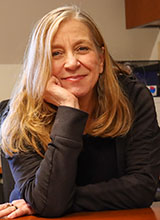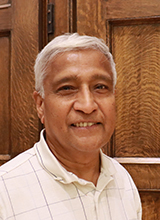
In March of 2020, students left for spring break and were told not to return to campus. The world was hit with an existential crisis – a global pandemic – the worst one since the influenza outbreak of 1918.
As the country locked down to carry out everyday life from the confines of its homes, four Yale lecturers recommitted themselves to providing a first-rate chemistry education to some 250 undergraduate students.
They adapted their method of teaching to accommodate government mandates to isolate from public settings. And much like the rest of the nation, people pulled together to get the job done.
In the 14 months that followed, lecturers, preceptors, graduate student teaching assistants (TAs), and lab staff doubled down in a team effort to safely teach students chemistry.
What follows are the stories of these lecturers.
Christine DiMeglio
 From the moment she was caught off guard by the state of emergency, Senior Lecturer Christine DiMeglio held strong to her commitment to teach organic chemistry. Little did she know how hard she and the lab team would have to work over the next five semesters to make that a reality.
From the moment she was caught off guard by the state of emergency, Senior Lecturer Christine DiMeglio held strong to her commitment to teach organic chemistry. Little did she know how hard she and the lab team would have to work over the next five semesters to make that a reality.
In the spring of 2020, students were to complete the remaining four weeks of class from home. With much of the coursework done, DiMeglio finished the semester by putting together internet videos that demonstrated techniques, created new assignments based on the readings and videos, and prepared optional quiz questions to test student understanding. Students met with teaching assistants by Zoom each lab period to discuss the lab experiment, assignment, and video content.
But, still, this spring was a very distressing time. Some students who weren’t yet home were trying to find their way back. Others had sick family members and were worried about elderly relatives.
DiMeglio credits Laboratory Assistant Lisa Vitale’s support for enabling her to do her job with compassion. Vitale would alert DiMeglio when a student didn’t pass in their assignment so she could reach out to ask, ‘are you okay?’
For the summer session, DiMeglio pivoted again, learning how to pre-record all her labs and lectures and post them to Canvas, an education software new to her. For each of the five weeks, her students watched her recordings before meeting with her live via Zoom for problem-solving sessions. She demonstrated solutions by using the scribe and whiteboard functions on her tablet.
Then in fall 2020, the university allowed a reduced student population to return to campus. To ensure the mandated social distance, first-years, juniors, and seniors returned to the labs while sophomores remained home until the spring semester. Lab Manager Teresa Lara-Jaime was instrumental in redesigning the layout of equipment, materials, and workspace to ensure students maintained six feet of space between each other. Together, she and lab staff reconfigured the lab space to operate effectively and safely at 50% capacity.
Yet, there remained the other 50% of students at home who still needed to take the class. For them, DiMeglio played writer, director, producer, and lead actor to film all the experiments from beginning to end. She acknowledged Preceptor Dr. Aaron Clark as being instrumental, as his consistent presence in organic chemistry virtual lectures and labs had a calming influence on students during the pandemic.
When the time came for the at-home group to swap places with the in-person group, DiMeglio questioned the efficacy of her dual pedagogical approach. To her delight, the new group did more than adapt; they excelled and loved being in the lab.
By the second summer of the pandemic, they were offering lectures both remotely and in person. DiMeglio says by that point they were expert at both methods of delivery. And this was possible because everyone was committed to making education happen and everyone– lecturers, preceptors, TAs, and staff – did an amazing job.
For DiMeglio, she’s discovered the value in video tutorials as supplemental education and Canvas as a powerful tool. The experience has equipped her with more technological tools to provide an outstanding education.
Jonathan Parr
 In recounting their experience, Senior Lecturer Jonathan Parr emphasized the collaborative spirit with which everyone worked to deliver the same pre-pandemic chemistry education. Parr also saw the pandemic accelerate teaching innovations while confirming the importance of some traditions, like the campus setting itself – a dedicated learning space.
In recounting their experience, Senior Lecturer Jonathan Parr emphasized the collaborative spirit with which everyone worked to deliver the same pre-pandemic chemistry education. Parr also saw the pandemic accelerate teaching innovations while confirming the importance of some traditions, like the campus setting itself – a dedicated learning space.
Like DiMeglio, Parr finished up their lab course that first spring semester by video. And in the fall, they lectured a small off-sequence organic chemistry class live via Zoom, with the help of Preceptor Dr. Hannah Lant and several teaching assistants.
The TAs, who were still learning their role, had to discover how to deliver their sections in a new and different way. In the early days, before access to technology, the TAs wrote on their bedroom walls and windowpanes in the absence of chalkboards.
During the entire time of distance-learning, the Yale Poorvu Center for Teaching and Learning staff helped Parr record, edit, and post videos, utilize online testing and video conference platforms, and troubleshoot the grey areas of teaching.
When Parr noticed a drop in attendance at the discussion sections, they recrafted their class announcement emails to sympathize with students’ challenges and encourage their feedback through an anonymous tool. With this input, they provided resources and saw students re-engage.
Many traditions changed in almost an instant, and some for the better. Take for example, office hours. The chore of hiking up Science Hill to get an answer to a quick question was eased by hopping on a brief Zoom call, and virtual office hours became the new norm. The old way of administering an exam, which involved hours of printing and setting up rooms in various buildings, moved to an online platform. TAs could then grade on the go, at home or on the train, instead of in a set room.
But for some, not having a dedicated on-campus space to learn was a real challenge. One student sat on a section of kitchen floor in range of the neighbor’s Wi-Fi while another sat on a piece of cardboard in the garage – the only quiet place in the house.
Parr learned some students didn’t have electricity 24 hours a day, some didn’t have internet, and others took on roles of babysitter, caretaker, and breadwinner with the illness or loss of family members.
“It was an extraordinarily eye-opening experience for me,” Parr said. “Like all human experiences, there may be something to be learned. The thing that I learned is what an important leveling experience it is to have people come to campus to be students.”
At Yale, they have the dedicated space and resources to position them for success.
Parr also credits lab staff Teresa Lara-Jaime, Nicole Gibbs, and Lisa Vitale’s thoughtful proactiveness in reinventing the lab spaces to make in-person labs possible and safe once again.
Paul Cooper
 Fortunately for Lecturer Paul Cooper, his reasonably small class meant he could operate a socially distanced in-person lab. Being in person is critical for physical chemistry experiments reliant on vacuum lines, gas tanks, and liquid nitrogen – a bit too complicated to replicate at home.
Fortunately for Lecturer Paul Cooper, his reasonably small class meant he could operate a socially distanced in-person lab. Being in person is critical for physical chemistry experiments reliant on vacuum lines, gas tanks, and liquid nitrogen – a bit too complicated to replicate at home.
Instead, Cooper was confronted by a different challenge, a longstanding one he had been previously troubleshooting when the pandemic hit.
Having worked here just over a year, he was still acclimating to teaching physical chemistry or p-chem, a course with a campus-wide reputation of having a massive workload.
He was already restructuring the lab to try to reduce student workload when the university mandated remote lectures. Cooper’s new idea was to offer all lectures asynchronously, allowing students to view them any time they wanted and freeing up ‘lecture time’ for much-needed data discussion.
The lab experiments in p-chem require significantly more in-depth data analysis than students have experienced in their degree program up to that point. Cooper organized Friday ‘data discussions’ by videoconference, which allowed students to share their screens and dive into the nuts and bolts of managing their data – something difficult to articulate in a lecture hall setting.
This format has been so successful, as evidenced by positive student evaluations, that Cooper continued this practice once rooms opened up again. He has testified to this curriculum improvement in his portfolio for the Faculty Teaching Academy program he’s participating in through the Yale Poorvu Center for Teaching and Learning.
Narasimhan Ganapathisubramanian
 If someone believes the best way to learn chemistry is to do experiments with your hands, what does one do? Lecturer Narasimhan Ganapathisubramanian, who everyone calls Dr. G., has been teaching general chemistry this way for 29 years. When he received the news that students were not coming back from spring break to finish the semester in person and everything was going online, he had one long sleepless night.
If someone believes the best way to learn chemistry is to do experiments with your hands, what does one do? Lecturer Narasimhan Ganapathisubramanian, who everyone calls Dr. G., has been teaching general chemistry this way for 29 years. When he received the news that students were not coming back from spring break to finish the semester in person and everything was going online, he had one long sleepless night.
The next day he immediately went to work in the lab filming all the experiments, six hours a day for seven days straight, finishing just before the buildings were closed to everyone.
Dr. G. taught his summer session students via Zoom from a lectern in an empty lecture hall. And when the fall semester started, he too had half an at-home and half an in-person class. On one side of the lab, he would be helping students with their lab experiments, while on the other side of the lab, the TAs would be conducting the experiments live over videoconference for the at-home audience to watch. To condense a 4-hour lab session to one hour, they eliminated the usual repetition of experiments to confirm results.
Pedagogically, he didn’t change a thing. Students still learned the same concepts, lab skills, and overall chemistry. The only difference was they now had videos available to supplement their education. And for him, producing them wasn’t a challenge. He says it’s his duty to teach his students, and he did whatever he needed to do to make that happen.
The challenge of remote learning enforced a shake-up to teaching norms. Each lecturer, preceptor, TA, and staff member came away from the experience with lessons learned, silver linings, and new practices.
The four lecturers, Professors DiMeglio, Cooper, Parr, and G, collaborated intensely, or as Parr puts it, “offensively.” They came up with a sequence for who would do what if one of them were to come down with COVID and could not teach their class.
The intense reorganization and look at labs and classes prompted a broader conversation for them, one which assesses what happens in each class and how they fit together with the overall introductory chemistry curriculum.
Now that things have calmed down a bit, they’re eager to see what else they can restructure.
Meet the Lecturers
Learn more about the lecturers at their biography page.